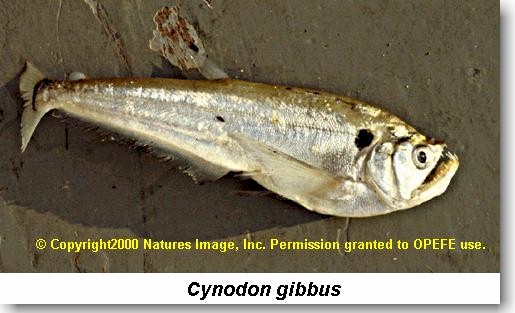 WELCOME TO OPEFE ARCHIVES
WELCOME TO OPEFE ARCHIVESSubfamily Cynodontinae
Eigenmann, 1907
genus Cynodon
Agassiz, 1829
FROM FRANK MAGALLANES
The subfamily Cynodontinae can be easily distinguished by other characiformes by their oblique mouths and a pair of highly formed dentary canines. The species placement is complex and under debate. Howes's (1976) concept of the Cynodontini included Roestes. But Toledo-Piza (2000) remarked herein that Cyondontinae includes only the genera Cynodon, Rhaphiodon, and Hydrolycus. Lucena and Mendez (1998) placed the Cynodontinae together with the Roesteinae (which included Roestes and Gilbertolus) in the family Cynodontidae. The genus Cynodon (Agassiz, 1829) includes the following species by key:
THREE (3) VALID SPECIES
|
C. gibbus Amazon and Orinoco R. basins and rivers of Guyana: Bolivia, Brazil, Ecuador, Guyana, Peru and Venezuela. |
C. meionactis Coastal rivers in French Guiana and Suriname |
C. septenarius Amazon and upper Orinoco R. basins and rivers of Guyana: Brazil, Guyana and Venezuela. |
C. gibbus was described on a the basis of a single specimen collected by Spix and Martius and originating from the rivers of Brazil (1829).
C. meionactis, a paratype was examined by Mônica Toledo-Piza (MNHN 1998-400) and one monotype specimen of C. meionactis (MNHN 1998-1769). Dr. M. Jégu checked characters of the holotype (MNHN 1998-0397). Toledo-Piza concluded that C. meionactis Géry et al., 1999, is different from C. septenarias.
C. septenarius, a new species was originally misidentified by Eigenmann (1912: 395 British Guiana [=Guyana]; description). C. septenarius lacks the band of dark pigmentation covering the base of the caudal-fin rays that is characteristic of C. gibbus.
KEYS
1. Branched pelvic-fin rays 8; band of dark pigmentation covering caudal-fin base....................2
-- Branched pelvic-fin rays 7; no band of dark pigmentation covering base of caudal fin, orbital diameter 30.1--34.4 of HL (Rio Amazonas and its tributaries between mouths of Rios Içá and Tapajós; Essequibo River drainage and Demerara River in Guyana; upper portions of Río Orinoco basin in Venezuela.......................C. septenarius, a new species
2. Orbital diameter 24.9--33.8 of HL (mean 29.2), branched anal-fin rays 68-80 (2 specimens with 65 rays) (Rio Amazonas and Río Orinoco basins, Rupununi River in Guyana, Rio Tocantins drainage and Rio Pindaré system, state of Maranhão, Brazil).........................C. gibbus
-- Orbital diameter 29.8--34.4 of HL (mean 31.8), branched anal-fin rays 63-67 (upper Maroni River, French Guiana)......................C. meionactis
The species is very similar appearing to the genus Hydrolycus. The anal fin of this species helps in identifying between the genera. The anal fin starts anterior of the dorsal fin. In Hydrolycus the anal fin starts posterior of the dorsal fin. The fish is strictly ichthyophagous like other members of the clade.
REFERENCES
Spix, J. B. von and L. Agassiz 1829-3, Selecta genera et species piscium quos in itinere per Brasiliam annos MDCCCXVII-MDCCCXX jussu et auspiciis Maximiliani Josephi I.... colleget et pingendso curavit Dr J. B. de Spix.... Monachii. Selecta Piscium Brasiliam: Part 1: i-xvi + i-ii + 1-82, Pls. 1-48;, Part 2: 83-138, Pls. 49-101. [Part 1 published June 1829, part 2 Jan. 1831; see Kottelat 1988 [ref. 13380], Whitehead & Myers 1971, Pethiygoda & Kottelat 1998
Géry, J., P.-Y. Le Bail and P. Keith 1999 (2 Feb.) Cynodon meionactis sp. n., un nouveau characide endémique du bassin du Haut Maroni en Guyane, avec une note sur la validité du genre Cynodon (Teleostei: Ostariophysi: Characiformes). Rev. Fr. Aquariol. v. 25 (no. 3-4) [1998]: 69-77. [English summ.]
Taphorn, D. C. 1992, The characiform fishes of the Apure River drainage, Venezuela. Biollania Edición Especial - No. 4. Monografias Cientificas del Museo de Ciencias Naturales, UNELLEZ -- Guanara, estado Portuguesa, Venezuela. 1-537.
Toledo-Piza, Monica 2000 (2 Feb.),The Neotropical fish subfamily Cynodontinae (Teleostei: Ostariophysi: Characiformes): a phylogenetic study and a revision of Cynodon and Rhaphiodon. Am. Mus. Novit. No. 3286: 1-88.
Reis, R. E., S. O. Kullander and C. J. Ferraris, Jr. 2003, Check list of the freshwater fishes of South and Central America. Check list Freshw. Fishes South & Cent. Amer. 2003: i-xi + 1-729.
USE YOUR BACKSPACE OR CLICK HERE TO RETURN OTHER PREDATORY FISHES
CLICK HERE TO RETURN RESEARCH PAGE
The OPEFE web site and its contents; is disclaimed for purposes of Zoological Nomenclature in accordance with the International Code of Zoological Nomenclature, Fourth Edition, Article 8.3 and 8.4. No new names or nomenclature changes are available from statements at this web site.
Copyright© 1994-2012 Oregon Piranha Exotic Fish Exhibit (The OPEFE fish exhibit is permanently CLOSED as of 2000) Sutherlin, Oregon. Information posted on this web site is archival data on fish scientific classifications and other information. DISCLAIMER: The copyrighted material may not be used for any purpose other than private study, scholarship or research. Cited information requires credit and this link www.opefe.com. All rights reserved. All images shown (unless otherwise noted) is property of OPEFE.
UPDATED: 12/05/2015